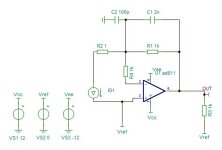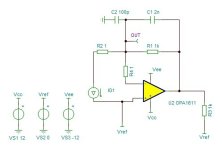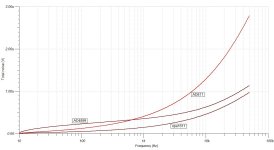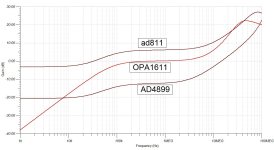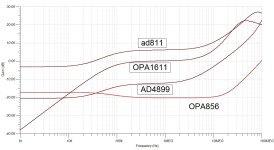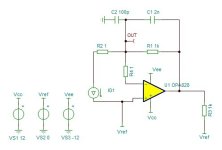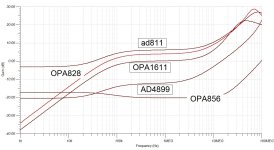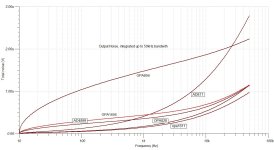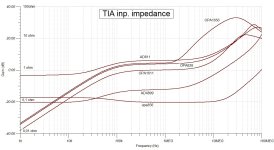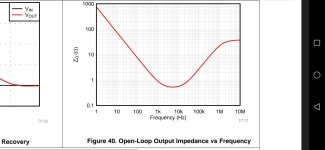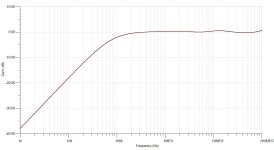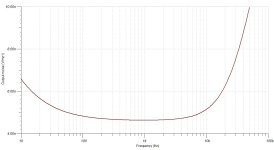This thread sparked my curiosity.. is it for granted, that a CFA with low 1/F noise corner is the best under the sun? How about modern fast VFA parts.. I have shown the OPA856 before, but OK, it shows high-ish 1/F noise corners (though for me don't seem that tragic).
Looking closer, the AD811 has the drawback of instability (with Cfeedback) without that certain 1kohm series 'damping', compensation resistance inserted at the -In input.
The problem is that once this compensation part is inserted, we can say goodbye to the most desireable feature of the CFB opamp -the 'natural' low impedance at the -In pin.
Also, that inserted 1kohm series res. brings at once 20nV/sqrtHz extra noise on -In input. bye bye 1nV/sqrtHz nominal input noise! sounded so nice, in fact could not ne true..
Also, the compensation resistor forms a divider with -In input node ~15ohm impedance, so some kind of 'noise gain loss' is introduced, we loose loop gain efficiency.
Here it is a sketch of my sim file:
- the actual values are arbitrary, I've been concentrating on the comparison of different parts in the same circuit, though tried to choose close to the usual values. that input 100pF wish to represent stray capacity in dac output circuit. C feedback again, only approximately the usual applied range.
Looking closer, the AD811 has the drawback of instability (with Cfeedback) without that certain 1kohm series 'damping', compensation resistance inserted at the -In input.
The problem is that once this compensation part is inserted, we can say goodbye to the most desireable feature of the CFB opamp -the 'natural' low impedance at the -In pin.
Also, that inserted 1kohm series res. brings at once 20nV/sqrtHz extra noise on -In input. bye bye 1nV/sqrtHz nominal input noise! sounded so nice, in fact could not ne true..
Also, the compensation resistor forms a divider with -In input node ~15ohm impedance, so some kind of 'noise gain loss' is introduced, we loose loop gain efficiency.
Here it is a sketch of my sim file:
- the actual values are arbitrary, I've been concentrating on the comparison of different parts in the same circuit, though tried to choose close to the usual values. that input 100pF wish to represent stray capacity in dac output circuit. C feedback again, only approximately the usual applied range.
Attachments
Last edited:
So, I tried to sim three parts:
AD811; the popular CFA;
OPA1611 (VFA, classic for I/V); ADA4899 (just to see what a real good VFA could offer)
First round of comparisons is the noise on the output:
I do not see the AD811 as the absolut champion here..
AD811; the popular CFA;
OPA1611 (VFA, classic for I/V); ADA4899 (just to see what a real good VFA could offer)
First round of comparisons is the noise on the output:
I do not see the AD811 as the absolut champion here..
Attachments
Now the interesting part: how about the real (simulated hehe) impedance at the Feedback node in an actual applied circuit:
I beg your pardon, in Tina is a bit awkward the presentation of the result: we see the log. value with respect to 1ohm (0dB= 1ohm, -20dB =0,1ohm, +10dB =3ohm etc..)
I hope it shows what I tried to describe: The AD811 is far from the best result, at least up to 100MHz...
I beg your pardon, in Tina is a bit awkward the presentation of the result: we see the log. value with respect to 1ohm (0dB= 1ohm, -20dB =0,1ohm, +10dB =3ohm etc..)
I hope it shows what I tried to describe: The AD811 is far from the best result, at least up to 100MHz...
Attachments
Last edited:
In a practical I/V circuit the feedback node input impedance is depending on both the available loop gain, & the actual Rf value. Higher Rf > higher (worse ) input impedance. So in active I/V circuits the higher the dac output current, the lower can be Rf and better conditions for summing node impedance..
Yeah that 1 k resistor...
When you know 100 ohms is already 1 nV more.
You want I sent you a proto with ad828 input i/v with low stray inductance and stray capacitance at the input (if you have two ad1862 chips) ? Story to measure in real....
When you know 100 ohms is already 1 nV more.
You want I sent you a proto with ad828 input i/v with low stray inductance and stray capacitance at the input (if you have two ad1862 chips) ? Story to measure in real....
Dear Iggy! Nice offer, thank You. As a matter of fact, I have the OPA828 chips (I use them in different places, in my dac, amps etc..) and also have evaluation boards for them, so I can actually assemble a ?correct implementation of I/V to test.
I do leg behind, instead, with the 1862 implementation..🙄
I am too much saturated (nicely) with my ak4499 dac from Yanasan..🙂
I do leg behind, instead, with the 1862 implementation..🙄
I am too much saturated (nicely) with my ak4499 dac from Yanasan..🙂
I see the OPA1611 ivery near the AD828. The AD828 is not my prefered I/V OPA while one of the best I have found. At the opposit I find the close OP1611 to be very borying at that task... I am not the only one that experienced it. A little "noisy" op1656 is much more nice at ears than the opa1611.
That opa 856 has some linearity... high SR iirc.
That opa 856 has some linearity... high SR iirc.
That jump in the 1656 inp. impedance curve .. how can that happen? An error in the spice model..🤔..
Or.. open loop output impedance excursions maybe?
I have quickly found an exchange with JohnC here, talking properly about that.:
""
3. OPA1656 will not have the flat, 5 ohm, output impedance of the OPA1622. Combining a rail-to-rail output stage with a 3 gain stage architecture in CMOS normally results in regions where the output impedance is inductive. There will be a graph in the final datasheet.
""
Looked up the datasheet. It's clearly stated:
Or.. open loop output impedance excursions maybe?
I have quickly found an exchange with JohnC here, talking properly about that.:
""
3. OPA1656 will not have the flat, 5 ohm, output impedance of the OPA1622. Combining a rail-to-rail output stage with a 3 gain stage architecture in CMOS normally results in regions where the output impedance is inductive. There will be a graph in the final datasheet.
""
Looked up the datasheet. It's clearly stated:
Attachments
Last edited:
Yeah that 1 k resistor...
When you know 100 ohms is already 1 nV more.
This paper might be of interest, it suggests the 1k isn't the only possible solution : https://www.ti.com/lit/an/slyt081/slyt081.pdf
Very nice article.
Though a ferrite bead will increase the impedance at the input node the same way as the series 1kohm res, at those frequencies where it 'hurts'..
It does help with less noise in the audio range, but do not resolve the rising impedance at high frequencies.🤔
What about a 'turbo' solution, like an opa1611 with max ~1ohm impedance all the way up to 100/200MHz?
with only a little noise penalty
Though a ferrite bead will increase the impedance at the input node the same way as the series 1kohm res, at those frequencies where it 'hurts'..
It does help with less noise in the audio range, but do not resolve the rising impedance at high frequencies.🤔
What about a 'turbo' solution, like an opa1611 with max ~1ohm impedance all the way up to 100/200MHz?
with only a little noise penalty
Attachments
what about making with it a second order low pass at this corner with a shunt cap or if not feasible swap the ferrite by a smd coil ? Too much inductance maybe? not linear ? Added input stray capacitance due to the footprint of such parts hence less linearity ?
opa1611 40 M hz at unity gain (not bad, not great for a dac output) ; SR is not great : 27 uV for that task but certainly not the most arming. The settling time is certainly bad. Source impedance of the AD1862 is 2k6 Z, certainly too high for that chip. (ad797 or opa211 better here in the family of low noise bjt opa?)
Perhaps the max flatness is important for a dac chip currentto voltage conversion and a 0.1 % max flat is the thing to focus on ? Current noise input is low but a fet one is by definition greater : the ad828 is in the fA range...
It had not passed audiophile ears tastes... maybe because its a base input topology ?
ADA4899and opa856 make me curious... There are also opa with noise spec like the the 1611 but with a real much greater band width and mostly far better SR and 0.01% settling time for that difficult transimpedance task for an operational amplifier. IMHO with my basic level and having heard some opa here as well.
Also : why not about an hybrid with the sorted out Ti fet pair in soic 8 footprint at input job, then... (opa861 in emitter input conf,) ... then ,... EMI reenforced buffer OPA?
To be continued
opa1611 40 M hz at unity gain (not bad, not great for a dac output) ; SR is not great : 27 uV for that task but certainly not the most arming. The settling time is certainly bad. Source impedance of the AD1862 is 2k6 Z, certainly too high for that chip. (ad797 or opa211 better here in the family of low noise bjt opa?)
Perhaps the max flatness is important for a dac chip currentto voltage conversion and a 0.1 % max flat is the thing to focus on ? Current noise input is low but a fet one is by definition greater : the ad828 is in the fA range...
It had not passed audiophile ears tastes... maybe because its a base input topology ?
ADA4899and opa856 make me curious... There are also opa with noise spec like the the 1611 but with a real much greater band width and mostly far better SR and 0.01% settling time for that difficult transimpedance task for an operational amplifier. IMHO with my basic level and having heard some opa here as well.
Also : why not about an hybrid with the sorted out Ti fet pair in soic 8 footprint at input job, then... (opa861 in emitter input conf,) ... then ,... EMI reenforced buffer OPA?
To be continued
Last edited:
I wonder also about Nelson Papa DIY preamp little board with a JFE2140 at input to avoid the NLA fet or the matching of the two inputs fet, and a shunt resistor at the output for the I/V ? Sorry just guessing, it is above of my head...
Channel separation in the LM4562 dual opamp is 118 dB (@ 1 kHz). It's better than 150 dB (1 kHz, 5 kΩ load) and better than 120 dB (1 kHz, 600 Ω load) in the OPA1612. So while you're correct in theory, channel separation is not really much of a practical concern.
I prefer the layout of the dual opamps, in particular that the output is right next to IN-, which makes the feedback network nice and tight. The single opamps allow for a nice flow left-to-right, so line the opamps up horizontally (assuming pin 1 is in the upper left). The dual opamps allow for a good layout end-to-end, so align them vertically, one above the other (again assuming pin 1 in the upper left). That dual layout also has the advantage of allowing for easy routing of the power supply, which isn't as easy with the single opamps.
I don't really have an issue with single vs dual, but in audio I'll always use the dual because I always need one per channel and single opamps provide no tangible benefit to me.
Some high-performance opamps are only available as dual, especially for audio opamps. Take the LM4562/LME49720 for example. There used to be a single version, the LME49710, but TI killed it. But, yes. There are some that are only available in single. OPA627 springs to mind.
Tom
Hello Tom,
Did you experienced better sonic result when these where caned (HA round package) ?
What would be your fav nowadays ? Ultra linear input newer lines ? (ADA4898, ADA4899, .... ?)
AD4899 maybe easier to make stable than OPA856 ?
thanks
I've never been able to measure any difference between the two, so I highly doubt any perceived difference would be due to a difference in the stimulus that reached my ears.Did you experienced better sonic result when these where caned (HA round package) ?
LM4562. OPA627 is nice but very expensive. OPA1612 is nice but can be a tough dance partner. OPA1656 is nice if you can tolerate the higher 1/f noise.What would be your fav nowadays ?
Tom
Does anyone need LM4562s? I have a few hundred extra. They are on SOIC to DIP adapter boards and need the pins soldered in. Berg pins work well. PM me if interested. Cheers!
- Home
- Source & Line
- Digital Line Level
- OPAMP single or dual? (DAC output stage)
